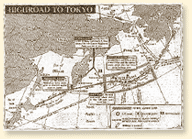

"High Road to Tokyo"
The Globe and Mail, May 3, 1943 |
The Aleutians Campaign, 1942-1943
In June 1942, some 8,500 Japanese personnel, supported by naval
forces, occupied the islands of Attu and Kiska, American parts of
Alaska at the western end of the Aleutian island chain. Their aim,
and it was successful, was to distract the
and cause them to take resources away from more significant areas in the
central Pacific. This small single landing in North America, in a place
closer to Siberia than to United States-owned mainland Alaska,
alarmed the inhabitants of the Canadian and American Pacific
northwest. They all demanded an end to the occupation.
bombing
aircraft were already patrolling the area from bases in Alaska,
and now fighter squadrons moved north-west and flew alongside the
Americans in operations over the islands. One formation of five
Canadians was lost when their Kittyhawk fighters flew into a
fog-covered mountainside in July 1942.
Leader K.A. Boomer shot down a Japanese seaplane
fighter over Kiska in September.
An American ,
supported by three battleships, attacked Attu
in May 1943. Two Canadian corvettes, HMCS Dawson and Vancouver,
provided anti-submarine support. It took the Americans twenty days
and nearly 4,000 casualties to eliminate the much smaller Japanese
force, which fought to the death. An even larger Allied force
assembled to re-take Kiska - nearly 30,000 American soldiers and
5,300 Canadians of the 13th Canadian Infantry
and the 1st Special Service Force. The Canadians included many
conscripts ( see
Conscription ) who were at the time liable for service anywhere in North
America.
When the landings finally went ashore on August 15, 1943, after three
weeks of bombardment by ships and aircraft, the troops found that
the Japanese soldiers had slipped away. Tragically, twenty Americans and four Canadians
died and fifty Americans and one Canadian were wounded as they shot each other in the
fog or tripped mines and booby traps.
Related Newspaper Articles
English Articles
French Articles
-
Le Japon attaquerait l'Alaska
Le Devoir, 09/05/1942
-
"Deux raids japonais sur la nase navale de Dutch Habor, en Alaska"
Le Devoir, 04/06/1942
-
Le coup japonais de Dutch Harbor et la Défense du Canada
Le Devoir, 04/06/1942
-
Le Japon prétend avoir pris pied aux îles Aléoutiennes
Le Devoir, 10/06/1942
-
Occupation des Aléoutiennes
Le Devoir, 10/06/1942
-
Débarquement japonais à Attu
Le Devoir, 13/06/1942
-
"Les Japonais à Kiska, dans les Aléoutiennes"
Le Devoir, 22/06/1942
-
Des aviateurs canadiens dans les Aléoutiennes
Le Devoir, 29/09/1942
-
Engagement naval nippo-américain aux Aléoutiennes
Le Devoir, 29/03/1943
-
"Les Américains débarquent sur l'île d'Attou- Confirmation de washington au sujet de ce débarquement"
Le Devoir, 14/05/1943
-
Les opérations de l'ile d'Attou
Le Devoir, 15/05/1943
-
Les Américains continueraient de débarquer des troupes sur Attou
Le Devoir, 17/05/1943
-
Les Américains encerclent les Japonais sur l'île d'Attou
Le Devoir, 19/05/1943
-
La bataille d'Attou est un sucès complet
Le Devoir, 22/05/1943
-
Nouvelle attaque sur l'île d'Attou
Le Devoir, 28/05/1943
-
En Extreme-Orient
Le Devoir, 31/05/1943
-
Les pertes japonaises sur l'île d'Attou
Le Devoir, 02/06/1943
-
Ce qu'a coûté aux Américains la conquête d'Attou
Le Devoir, 04/06/1943
-
Les troupes canadiennes à Kiska
Le Devoir, 02/10/1943
-
Circulation libre dans l'Alaska
Le Devoir, 18/11/1943
|